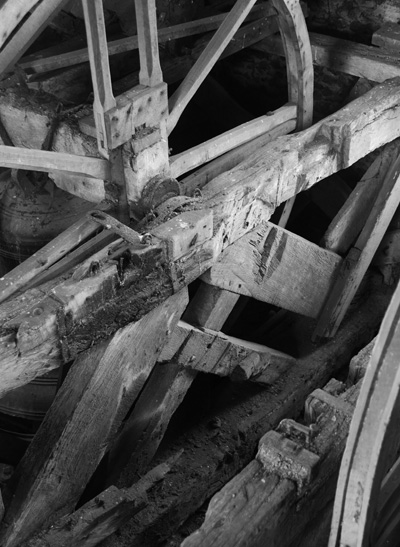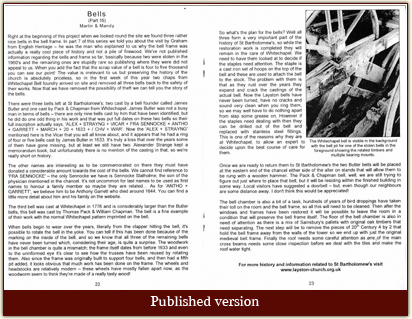Martin & Mandy

Right at the beginning of this project when we looked round the site we found three rather nice bells in the bell frame. In part 7 of this series we told you about the visit by Graham from English Heritage - he was the man who explained to us why the bell frame was actually a really cool piece of history and not a pile of firewood. We've not published information regarding the bells and frame so far, basically because two were stolen in the 1960's and the remaining ones are stupidly rare so publishing where they were did not appeal to us. When you add the fact that the scrap value of a bell is four to five thousand you can see our point! The value is irrelevant to us but preserving the history of the church is absolutely priceless, so in the first week of this year two chaps from Whitechapel Bell foundry arrived on site and removed all three bells back to the safety of their works. Now that we have removed the possibility of theft we can tell you the story of the bells.
There were three bells left at St Bartholomew's, two cast by a bell founder called James Butler and one cast by Pack & Chapman from Whitechapel. James Butler was not a busy man in terms of bells - there are only 9 bells cast by him that have been identified, but he did do one odd thing in his work and that was put full dates on these two bells so their full inscription actually says 'ALEX + STRAYNG + VICAR + FRA SENNOCKE + ANTHO + GARRETT + MARCH + 20 + 1633 + / CHV + WAR ' Now the 'ALEX + STRAYNG' mentioned here is the Vicar that you will all know about, and it appears that he had a ring of four or five bells cast by James Butler in 1633. It's truly a loss that over the years some of them have gone missing, but at least we still have two. Alexander Strange kept a memorandum book, but unfortunately there is no mention of the casting in that, so we're really short on history.
that have been identified, but he did do one odd thing in his work and that was put full dates on these two bells so their full inscription actually says 'ALEX + STRAYNG + VICAR + FRA SENNOCKE + ANTHO + GARRETT + MARCH + 20 + 1633 + / CHV + WAR ' Now the 'ALEX + STRAYNG' mentioned here is the Vicar that you will all know about, and it appears that he had a ring of four or five bells cast by James Butler in 1633. It's truly a loss that over the years some of them have gone missing, but at least we still have two. Alexander Strange kept a memorandum book, but unfortunately there is no mention of the casting in that, so we're really short on history.
The other names are interesting as to be commemorated on there they must have donated a considerable amount towards the cost of the bells. We cannot find reference to 'FRA SENNOCKE' – the only Sennocke we have is Sennocke Slatholme, the son of the physician mentioned in the chancel. It's not uncommon for last names to be used as first names to honour a family member so maybe they are related… As for 'ANTHO + GARRETT' we believe him to be Anthony Garrett who died around 1644. You can find a little more detail about him and his family on the website.
The third bell was cast at Whitechapel in 1776 and is considerably larger than the Butler bells, this bell was cast by Thomas Pack & William Chapman. The bell is a fine example of their work with the normal Whitechapel pattern imprinted on the bell.
When bells begin to wear over the years, literally from the clapper hitting the bell, it's possible to rotate the bell in the yoke. You can tell if this has been done because of the marking on the inside of the bell, and so we know that all three of the remaining bells have never been turned which, considering their age, is quite a surprise. The wood work in the bell chamber is quite a mismatch, the frame itself dates from before 1633 and even to the uninformed eye it's clear to see how the trusses have been reused by rotating them. Also since the frame was originally built to support 4 bells, and then had a fifth pit added, it looks obvious that much work has been done on the frame. The wheels and headstocks are relatively modern – these wheels have mostly fallen apart now, as the woodworm seem to think they're made of a really tasty wood!
So what's the plan for the bells? Well all three form a very important part of the history of St Bartholomew's, so while the restoration work is completed they will remain in the care of Whitechapel. We need to have them looked at to decide if the staples need attention. The staple is a cast iron set of hoops on the top of the bell and these are used to attach the bell to the stock. The problem with them is that as they rust over the years they expand and crack the castings of the actual bell. Now the Layston bells have never been turned, have no cracks and sound very clean when you ring them, so we may well have to do nothing apart from slap some grease on. However if the staples need dealing with then they can be drilled out of the bell and replaced with stainless steel fittings. This is one of the reasons why they are at Whitechapel, to allow an expert to decide upon the best course of care for them.
Once we are ready to return them to St Bartholomew's the two Butler bells will be placed at the eastern end of the chancel either side  of the alter on stands that will allow them to be rung with a wooden hammer.The Pack &Chapman bell, well, we are still trying tofigureout just where to place that bell, but it will be residing within the finished building in some way. Local visitors have suggested a doorbell – but, even though our neighbours are some distance away, I don't think this would be appreciated!
of the alter on stands that will allow them to be rung with a wooden hammer.The Pack &Chapman bell, well, we are still trying tofigureout just where to place that bell, but it will be residing within the finished building in some way. Local visitors have suggested a doorbell – but, even though our neighbours are some distance away, I don't think this would be appreciated!
The bell chamber is also a bit of a task, hundreds of years of bird droppings have taken their toll on the room and the bell frame, so all this will need to be cleaned. Then after the windows and frames have been restored it will be possible to leave the room in a condition that will preserve the bell frame itself. The floor of the bell chamber is also in need of attention as there is a mix of Sainsbury's pallets with original oak timbers that need separating. The next step will be to remove the pieces of 20th century 4 by 2 that hold the bell frame away from the walls of the tower so we end up with just the original medieval bell frame. Finally the roof needs some careful attention as one of the main cross beams needs some close inspection before we deal with the tiles and make the roof water tight.
 |
|
 |
